Samariá Gorge
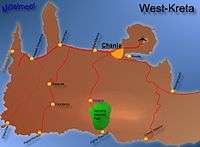
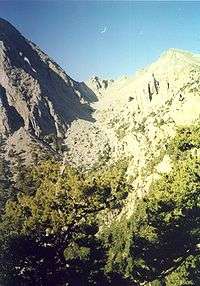
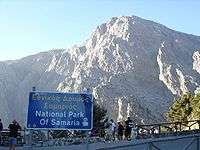
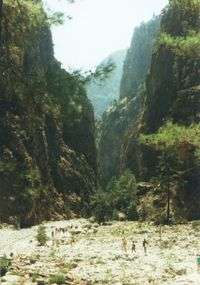
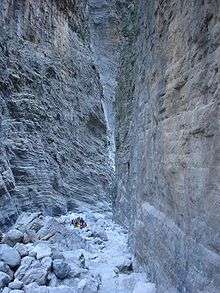
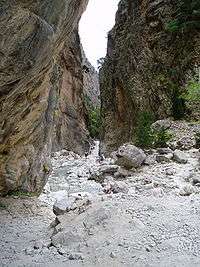
The Samariá Gorge (Greek: Φαράγγι Σαμαριάς or just Φάραγγας) is a National Park of Greece since 1962 on the island of Crete – a major tourist attraction of the island – and a World's Biosphere Reserve.
The gorge is in southwest Crete in the regional unit of Chania. It was created by a small river running between the White Mountains (Lefká Óri) and Mt. Volakias. There are a number of other gorges in the White Mountains. While some say that the gorge is 18 km long, this distance refers to the distance between the settlement of Omalos on the northern side of the plateau and the village of Agia Roumeli. In fact, the gorge is 16 km long, starting at an altitude of 1,250 m at the northern entrance, and ending at the shores of the Libyan Sea in Agia Roumeli. The walk through Samaria National Park is 13 km long, but one has to walk another three kilometers to Agia Roumeli from the park exit, making the hike 16 km long. The most famous part of the gorge is the stretch known as the Gates (or, albeit incorrectly, as "Iron Gates"), where the sides of the gorge close in to a width of only four meters and soar up to a height of almost 300 meters (980 feet). The gorge became a national park in 1962, particularly as a refuge for the rare kri-kri (Cretan goat), which is largely restricted to the park and an island just off the shore of Agia Marina. There are several other endemic species in the gorge and surrounding area, as well as many other species of flowers and birds.
The village of Samariá lies just inside the gorge. It was finally abandoned by the last remaining inhabitants in 1962 to make way for the park. The village and the gorge take their names from the village's ancient church, Óssia María.
A must for visitors to Crete is to complete the walk down the gorge from the Omalos plateau to Agia Roumeli on the Libyan Sea, at which point tourists sail to the nearby village of Sougia or Hora Sfakion, where they could spend a night there, or they could catch a coach back to Chania. The walk takes five to seven hours and can be strenuous, especially at the peak of summer.
Local tourist operators provide organized tours to the Gorge. These include bus transportation from one's hotel to the entrance (near Omalos village), and a bus connection that will be waiting for hikers after they disembark the ferry in Sougia or Sfakia (Chora Sfakion). If you are on your own, you can make a one-day round trip from Chania (see below) or from Sougia or Paleochora. Note that the morning buses from Sougia and Paleochora do not operate on Sunday. The ferries leave Agia Roumeli to Chora Sfakion (eastbound) and to Sougia/Paleochora (westbound) at 17:00.
There also exists a "lazy way" – from Agia Roumeli to the Gates, and back.
Information provided by the Chania Forest Protection Service[1]
- Visits to the National park are allowed from May 1 to October 15.
- Park visiting hours are 07:00 to 15:00 daily. From 15:00 to sunset, visitors are allowed to walk a distance of only two kilometers within the park, either from Xyloskalo or from Agia Roumeli.
- Within the park it is strictly prohibited to camp, stay overnight, light fires, or swim in the streams of the gorge.
How to visit from Chania
- There are daily buses starting from Chania to the head of the gorge, called Xyloskalo. The buses, marked "OMALOS", depart Chania Central Bus Station at 07:45 and 8:45; the fare for a round trip is €15.70.
- The morning buses take one hour. The gorge is 12.8 km (8.0 mi) long, but there is another distance of 3.2 km (2.0 mi) to walk after leaving the gorge to reach Agia Roumeli; you need five to six hours to walk the 16 km. Be aware that it's always going downhill and thus is strenuous to the knees.
- The entrance fee is €5 (free for children under the age of 15).
- There is plenty of drinking water all along the gorge. Hiking boots are recommended, also sneakers can be worn.
- At the end of the gorge plus 3.2 km (2.0 mi) is Agia Roumeli, a village with restaurants and accommodation, and boats to Chora Sfakion or Sougia. To return the same day, take the 17:30 (2016) boat (fare: €12,70, 2016) to Chora Sfakion.[2][3]
- From Sougia or Chora Sfakion, buses return to Chania, departing at 18:30; the bus always waits for the boat to arrive.
- Tickets for the two buses can be reserved at the ticket office at the Chania bus station ( ticket price day-return 15,70 €). The ticket for the boat can be purchased in Agia Roumeli only.
- There are daily guided tours operated by various travel agencies, whose cost is usually around €20 (2011) and which includes fare for buses and the tour guide. The price does not include boat tickets (€11) and entrance fees (€5.00), which is usually collected separately on the bus.
The choice of public transportation total price for one adult based in Chania is 30.30 € (2014).[4] This includes Samaria Gorge entrance ticket, travel by bus and return bus to Chania and the ferry boat that will take you from Agia Roumeli to Sfakia in order to take the return bus.
Other gorges in Crete
References
- ↑ Leaflet from NPS Tourist Office, 27/4/2008
- ↑ http://www.anendyk.gr/pages/en/timetable.php?lang=EN
- ↑ http://www.anendyk.gr/pages/en/prices.php
- ↑ http://www.samaria.gr/%CF%83%CF%87%CE%B5%CE%B4%CE%B9%CE%AC%CF%83%CF%84%CE%B5-%CF%84%CE%B7%CE%BD-%CE%B5%CF%80%CE%AF%CF%83%CE%BA%CE%B5%CF%88%CE%AE-%CF%83%CE%B1%CF%82/
External links
| Wikimedia Commons has media related to Samaria Gorge. |
- Samaria gorge portal
- Agia Roumeli ferry boat timetable and prices
- Chania bus timetables and prices
- Photos and Information about Samaria Gorge
- Guide to the gorge of Samaria
- Description of a walk down the Gorge
- Xyloskalo current weather conditions
Coordinates: 35°16′16″N 23°57′41″E / 35.27111°N 23.96139°E